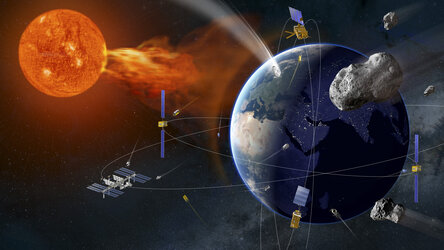GMES in Eastern Europe
As Europe’s Global Monitoring for Environment and Security programme nears its full operational phase, its benefits and economic potential for Eastern Europe came into focus last week at a conference in Bucharest, Romania.
In the summer of 2010, heavy rainfall unleashed floods in northern and eastern Romania. Over 20 people lost their lives, while hundreds of homes were destroyed. Thousands of hectares of farmland, forest and pastures were damaged.
SAFER, the emergency response service of Europe’s Global Monitoring for Environment and Security (GMES) programme, immediately stepped in. Using data from Earth-observing satellites, the organisation provided civil protection authorities with flood extent maps in near-real time.
GMES has been active in Eastern Europe for years, identifying sources of pollution in the Black Sea, providing emergency mapping services for mudslides in Bulgaria and monitoring biodiversity of protected areas in Romania.
These were just some of the examples presented at the ‘GMES: New Opportunities for Eastern Europe’ conference last week. The two-day event was held in Bucharest, Romania – ESA’s newest member state.
The conference aimed to increase awareness amongst Eastern European countries – and in particular the 12 new EU Member States – about GMES and its potential benefits for the environment, civil security and commerce.
Once GMES moves from its research and development phase to full operations in 2014, decision-makers will have access to reliable, timely and accurate information services to manage the environment, understand and mitigate the effects of climate change and ensure civil security.

The programme plans to extend and improve its services with the upcoming series of Sentinel satellites, which are being developed specifically for the operational needs of GMES. Together with in-situ data, the Sentinels will ensure the provision of an uninterrupted data and information flow to the users.
Opening the conference, the president of Romania’s National Authority for Scientific Research, Dragos Ciuparu, spoke about the ever-increasing relevance of Earth observation data not only in Romania, but also in the 12 new EU states.
Mr Ciuparu stressed the need to get the new EU Member States better acquainted with GMES and the role it can play in benefiting the creation and growth of small and medium businesses.
The economic benefits of the GMES programme also came into focus at the conference, as it will generate an estimated €4–12 for every €1 invested.
GMES will not only serve as a trigger for the creation of new markets, jobs, income and economic growth, it will also lead to a substantial amount of savings at both national and local levels.
GMES services will help to save costs through the improved management of natural resources and efficiency in the mitigation of emergency situations.















 Germany
Germany
 Austria
Austria
 Belgium
Belgium
 Denmark
Denmark
 Spain
Spain
 Estonia
Estonia
 Finland
Finland
 France
France
 Greece
Greece
 Hungary
Hungary
 Ireland
Ireland
 Italy
Italy
 Luxembourg
Luxembourg
 Norway
Norway
 The Netherlands
The Netherlands
 Poland
Poland
 Portugal
Portugal
 Czechia
Czechia
 Romania
Romania
 United Kingdom
United Kingdom
 Slovenia
Slovenia
 Sweden
Sweden
 Switzerland
Switzerland




























